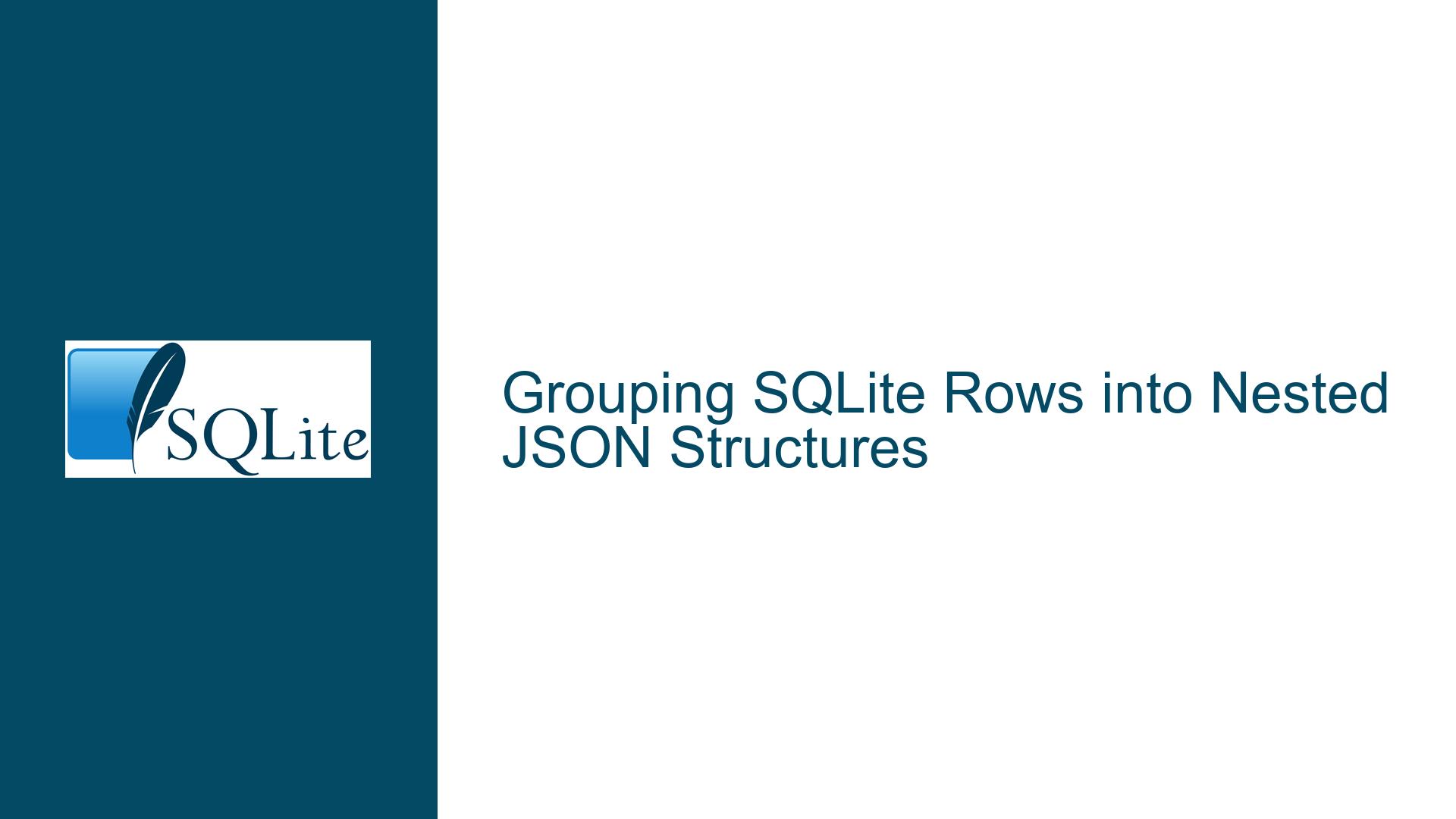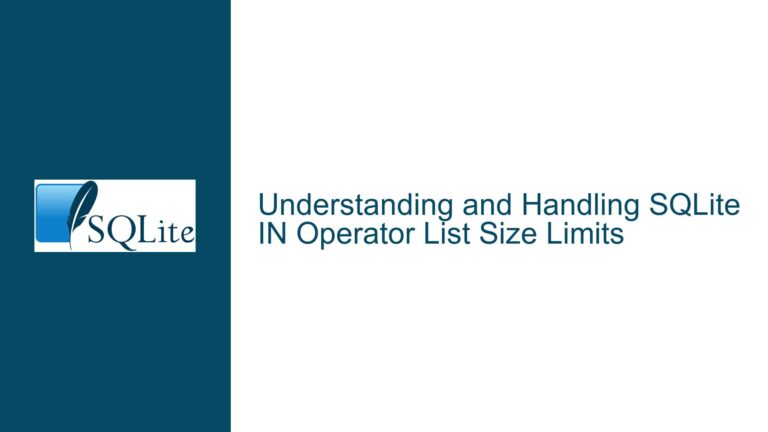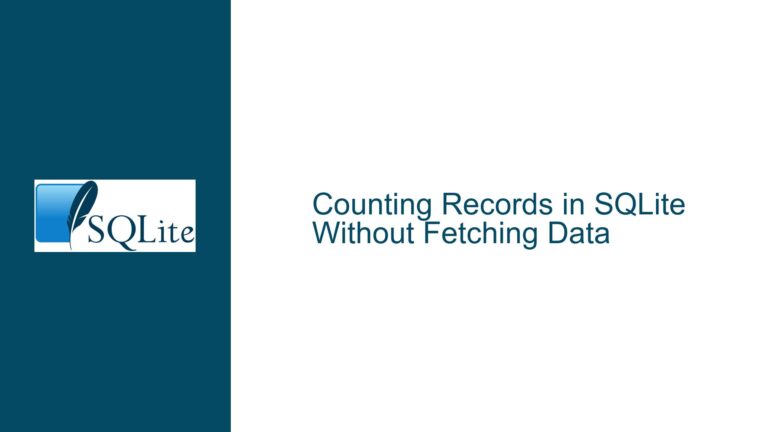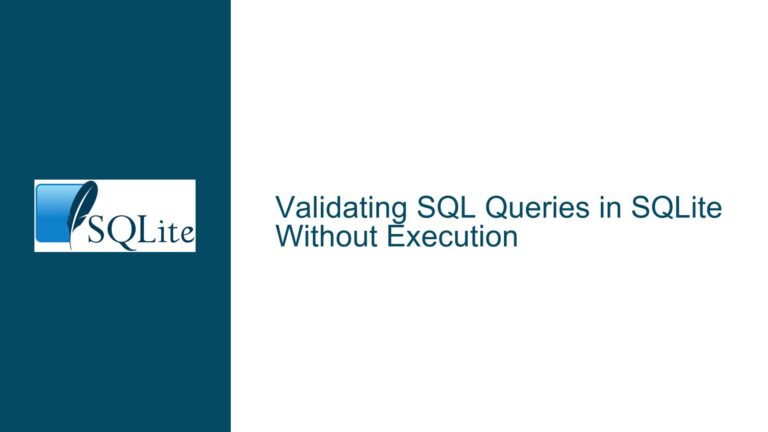Grouping SQLite Rows into Nested JSON Structures
Understanding the Desired JSON Structure and Current Query Limitations
The core issue revolves around transforming a flat SQLite query result into a nested JSON structure that groups related entities hierarchically. The current query produces a flat JSON array where each row represents a combination of district, zone, and school. However, the desired output requires nesting schools under their respective zones and zones under their respective districts. This hierarchical structure is more intuitive for representing relationships in the data but is not directly achievable with a straightforward SQL query.
The current query uses JSON_GROUP_ARRAY and JSON_OBJECT to construct JSON objects, but it lacks the ability to group and nest related entities. SQLite’s JSON functions are powerful but limited in their ability to perform complex aggregations and nesting directly within a single query. The challenge lies in restructuring the query to achieve the desired nested JSON output without sacrificing performance or readability.
Identifying the Root Cause: Lack of Hierarchical Grouping in SQLite
The primary limitation preventing the desired output is SQLite’s inability to perform hierarchical grouping directly within a single query. The current query joins the districts, zones, and schools tables, producing a flat result set where each row contains a district, zone, and school combination. While this is useful for many use cases, it does not align with the requirement of nesting schools under zones and zones under districts.
SQLite’s JSON functions, such as JSON_GROUP_ARRAY and JSON_OBJECT, are designed to work with flat result sets. They do not inherently support hierarchical grouping or nesting. To achieve the desired structure, the query must be restructured to first group schools by zones and then group zones by districts. This requires a multi-step approach, leveraging subqueries or intermediate result sets to build the nested structure incrementally.
Step-by-Step Solution: Building Nested JSON with Subqueries and Intermediate Results
To achieve the desired nested JSON structure, the query must be broken down into multiple steps. Each step will focus on grouping and nesting the data at a specific level of the hierarchy. The final result will be constructed by combining these intermediate results into a single JSON object.
Step 1: Group Schools by Zones
The first step is to group schools by their respective zones. This can be achieved using a subquery that aggregates schools into a JSON array for each zone. The subquery will use JSON_GROUP_ARRAY to create an array of school objects and JSON_OBJECT to construct each school object.
SELECT
zones.zone_code,
zones.name AS zoneName,
JSON_GROUP_ARRAY(
JSON_OBJECT('schoolName', schools.name)
) AS schools
FROM
zones
INNER JOIN
schools ON zones.zone_code = schools.zone_code
GROUP BY
zones.zone_code;
This query produces a result set where each row contains a zone and a JSON array of schools within that zone. The GROUP BY clause ensures that schools are grouped by their respective zones.
Step 2: Group Zones by Districts
The next step is to group zones by their respective districts. This requires another subquery that aggregates the results from Step 1 into a JSON array for each district. The subquery will use JSON_GROUP_ARRAY to create an array of zone objects and JSON_OBJECT to construct each zone object.
SELECT
districts.district_code,
districts.name AS districtName,
JSON_GROUP_ARRAY(
JSON_OBJECT(
'zoneName', zone_group.zoneName,
'schools', zone_group.schools
)
) AS zones
FROM
districts
INNER JOIN (
SELECT
zones.district_code,
zones.name AS zoneName,
JSON_GROUP_ARRAY(
JSON_OBJECT('schoolName', schools.name)
) AS schools
FROM
zones
INNER JOIN
schools ON zones.zone_code = schools.zone_code
GROUP BY
zones.zone_code
) AS zone_group ON districts.district_code = zone_group.district_code
GROUP BY
districts.district_code;
This query builds on the results from Step 1, grouping zones by districts and nesting the schools within each zone. The GROUP BY clause ensures that zones are grouped by their respective districts.
Step 3: Construct the Final JSON Object
The final step is to combine the results from Step 2 into a single JSON object. This can be achieved using JSON_GROUP_ARRAY to create an array of district objects and JSON_OBJECT to construct each district object.
SELECT
JSON_GROUP_ARRAY(
JSON_OBJECT(
'districtId', districts.district_code,
'districtName', districts.name,
'zones', district_group.zones
)
) AS result
FROM
districts
INNER JOIN (
SELECT
districts.district_code,
districts.name AS districtName,
JSON_GROUP_ARRAY(
JSON_OBJECT(
'zoneName', zone_group.zoneName,
'schools', zone_group.schools
)
) AS zones
FROM
districts
INNER JOIN (
SELECT
zones.district_code,
zones.name AS zoneName,
JSON_GROUP_ARRAY(
JSON_OBJECT('schoolName', schools.name)
) AS schools
FROM
zones
INNER JOIN
schools ON zones.zone_code = schools.zone_code
GROUP BY
zones.zone_code
) AS zone_group ON districts.district_code = zone_group.district_code
GROUP BY
districts.district_code
) AS district_group ON districts.district_code = district_group.district_code;
This query produces the desired nested JSON structure, with schools grouped under zones and zones grouped under districts. The JSON_GROUP_ARRAY and JSON_OBJECT functions are used to construct the final JSON object, ensuring that the hierarchy is preserved.
Optimizing the Query for Performance and Readability
While the above solution achieves the desired result, it can be optimized for performance and readability. One approach is to use Common Table Expressions (CTEs) to break down the query into smaller, more manageable parts. CTEs improve readability by allowing each step of the query to be defined separately, and they can also improve performance by reducing the complexity of the main query.
Using CTEs to Simplify the Query
The following query uses CTEs to define the intermediate results for grouping schools by zones and zones by districts. This approach makes the query easier to read and maintain.
WITH zone_group AS (
SELECT
zones.district_code,
zones.name AS zoneName,
JSON_GROUP_ARRAY(
JSON_OBJECT('schoolName', schools.name)
) AS schools
FROM
zones
INNER JOIN
schools ON zones.zone_code = schools.zone_code
GROUP BY
zones.zone_code
),
district_group AS (
SELECT
districts.district_code,
districts.name AS districtName,
JSON_GROUP_ARRAY(
JSON_OBJECT(
'zoneName', zone_group.zoneName,
'schools', zone_group.schools
)
) AS zones
FROM
districts
INNER JOIN
zone_group ON districts.district_code = zone_group.district_code
GROUP BY
districts.district_code
)
SELECT
JSON_GROUP_ARRAY(
JSON_OBJECT(
'districtId', districts.district_code,
'districtName', districts.name,
'zones', district_group.zones
)
) AS result
FROM
districts
INNER JOIN
district_group ON districts.district_code = district_group.district_code;
This query uses two CTEs, zone_group and district_group, to define the intermediate results for grouping schools by zones and zones by districts. The final query combines these results into the desired nested JSON structure. This approach improves readability and makes the query easier to debug and maintain.
Handling Edge Cases and Ensuring Data Integrity
When working with nested JSON structures, it is important to consider edge cases and ensure data integrity. For example, what happens if a district has no zones or a zone has no schools? The current query assumes that every district has at least one zone and every zone has at least one school. However, this may not always be the case.
To handle these edge cases, the query can be modified to include LEFT JOIN instead of INNER JOIN. This ensures that districts and zones without corresponding schools are still included in the result set. Additionally, the JSON_GROUP_ARRAY function can be used with a conditional expression to handle cases where no schools are present.
Modifying the Query to Handle Edge Cases
The following query uses LEFT JOIN and conditional expressions to handle edge cases where districts or zones may have no corresponding schools.
WITH zone_group AS (
SELECT
zones.district_code,
zones.name AS zoneName,
JSON_GROUP_ARRAY(
JSON_OBJECT('schoolName', schools.name)
) AS schools
FROM
zones
LEFT JOIN
schools ON zones.zone_code = schools.zone_code
GROUP BY
zones.zone_code
),
district_group AS (
SELECT
districts.district_code,
districts.name AS districtName,
JSON_GROUP_ARRAY(
JSON_OBJECT(
'zoneName', zone_group.zoneName,
'schools', COALESCE(zone_group.schools, JSON_ARRAY())
)
) AS zones
FROM
districts
LEFT JOIN
zone_group ON districts.district_code = zone_group.district_code
GROUP BY
districts.district_code
)
SELECT
JSON_GROUP_ARRAY(
JSON_OBJECT(
'districtId', districts.district_code,
'districtName', districts.name,
'zones', COALESCE(district_group.zones, JSON_ARRAY())
)
) AS result
FROM
districts
LEFT JOIN
district_group ON districts.district_code = district_group.district_code;
This query uses LEFT JOIN to ensure that districts and zones without corresponding schools are included in the result set. The COALESCE function is used to handle cases where no schools are present, ensuring that the JSON structure remains consistent.
Conclusion: Achieving Nested JSON Structures in SQLite
Transforming flat SQLite query results into nested JSON structures requires a multi-step approach that leverages subqueries, CTEs, and SQLite’s JSON functions. By breaking down the problem into smaller steps and handling edge cases, it is possible to achieve the desired hierarchical structure. The final query is optimized for performance and readability, ensuring that the nested JSON output is both accurate and efficient.
This approach can be adapted to other use cases where hierarchical data needs to be represented in JSON format. By understanding the limitations of SQLite’s JSON functions and applying best practices for query optimization, developers can create robust and maintainable solutions for complex data transformation tasks.






